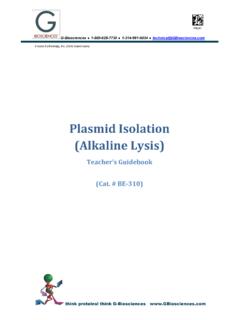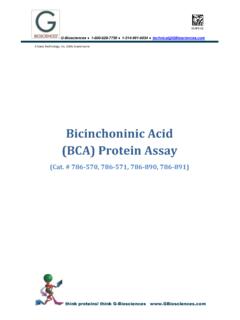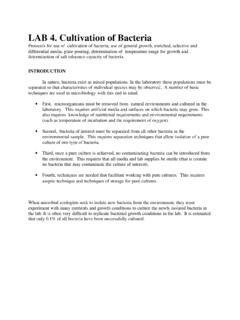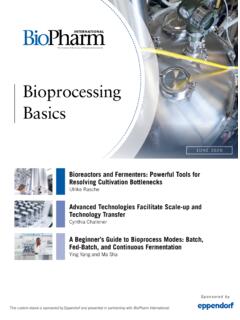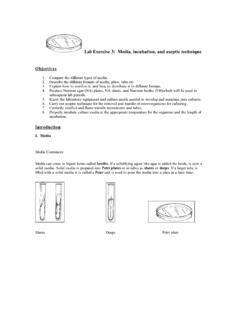Transcription of Isolation &Characterization of Bacteria - G-Biosciences
1 G-Biosciences 1-800-628-7730 1-314-991-6034 A Geno Technology, Inc. (USA) brand name think proteins! think G-Biosciences PR025 Isolation & Characterization of Bacteria Teacher s Handbook (Cat. # BE 204) Page 2 of 12 MATERIALS INCLUDED WITH THE KIT .. 3 SPECIAL HANDLING INSTRUCTIONS .. 3 ADDITIONAL EQUIPMENT REQUIRED .. 4 TIME REQUIRED .. 4 OBJECTIVES .. 4 BACKGROUND .. 4 TEACHER S PRE EXPERIMENT SET UP .. 5 MATERIALS FOR EACH GROUP .. 6 PROCEDURE .. 7 DAY 1 .. 7 RESULTS, ANALYSIS & ASSESSMENT .. 10 MATERIALS INCLUDED WITH THE KIT This kit has enough materials and reagents for 24 students (six groups of four students). 1 bottle PBS 10 Cotton Swabs 12 Inoculating Loops 6 vials Loop Wash 2 packs LB Agar 12 Petri Dishes 6 vials LB Broth 10 Discs: Ampicillin Discs 10 Discs: Penicillin Discs 30 Discs: Blank Discs 6 Forceps 20 Centrifuge Tubes (2ml) 4 Transfer pipettes (Large) 1 Bacterial Gram Staining Kit 1 bottle Gram Stain: Decolorizer Solution 6 Glass Slides 1 bottle Gram Crystal Violet 1 bottle Gram Iodine 1 bottle Gram Safranin SPECIAL HANDLING INSTRUCTIONS Store Ampicillin Discs and Penicillin Discs at 4 C.
2 All other reagents can be stored at room temperature. Briefly centrifuge all small vials before opening to prevent waste of reagents. The majority of reagents and components supplied in the BioScience Excellence kits are non toxic and are safe to handle, however good laboratory procedures should be used at all times. This includes wearing lab coats, gloves and safety goggles. For further details on reagents please review the Material Safety Data Sheets (MSDS). Page 3 of 12 The following items need to be used with particular caution. Part # Name Hazard G051 Gram Crystal Violet Flammable G081 Gram Stain: Decolorizer Solution Flammable L041 Loop Wash Flammable ADDITIONAL EQUIPMENT REQUIRED Shaking Incubator Incubator Autoclave* Bunsen Burner * 100ml premade bottles of LB agar (L011), which is melted in a boiling waterbath, can be used if an autoclave is not available.
3 You will require 3 x LB Agar bottles. TIME REQUIRED Day 1: 30 minutes Day 2: 30 minutes Day 3: 1 2 hours Day 4: 20 minutes OBJECTIVES Isolation of Bacteria from test samples Characterization of isolated Bacteria Characterization of the isolated Bacteria with gram staining BACKGROUND An interesting hands on lab activity that teaches students the skills required for the Isolation of Bacteria from test samples. This kit teaches aseptic handing techniques and cultivation of Bacteria . Using theses bacterial culture techniques students discover and isolate the Bacteria present around us. Following Isolation of Bacteria , students characterize the Bacteria with household disinfectant products and antibiotics.
4 Students learn and understand the significance of bacterial Isolation in applied biotechnology. The Gram staining method was first described in 1844 by the Danish bacteriologist Hans Christian Gram, after whom the test was named. The Gram staining test for Bacteria is one of the most important tests in microbiology and is often one of the first tests performed in the identification of Bacteria . Page 4 of 12 The primary stain used in this kit for the Gram staining is crystal violet; however methylene blue is an adequate substitute. The microorganisms ( Bacteria ) that retain the primary crystal violet stain appear as a purple brown color under the microscope.
5 The stained Bacteria are referred to as Gram positive. The microorganisms that do not retain the primary stain and are a red color are Gram negative. The basic principle of Gram staining is the properties of certain Bacteria cell walls to retain the crystal violet dye. The cell walls for Gram positive microorganisms have a higher peptidoglycan and lower lipid content than Gram negative Bacteria . The mechanics of the Gram staining method is that the Bacteria cell walls retain the crystal violet and subsequently added iodine, which complexes with the crystal violet, preventing the easy removal of the dyes. This step is known as the fixing the dye step.
6 During the subsequent addition of a decolorizer, a mixture of acetone and ethanol solvents, Gram positive cell walls dehydrate, closing the pores in the cell wall, resulting in the retention of the crystal violet:iodine complexes. In contrast, the decolorizer dissolves the higher lipid content of Gram negative Bacteria and the primary stain is able to leach into the solvent, essentially washing away the dye, leaving the Gram negative Bacteria unstained. The length of the decolorization stage is critical as prolonged decolorizing will remove the primary stain from the Gram positive cells and this will lead to false negatives during characterization of the microorganisms.
7 Finally, in order to visualize the unstained Gram negative Bacteria , a counter stain is added. This kit uses safranin, a basic stain that stains Bacteria red. Some Bacteria stain weakly with Safranin and the alternative counter stain Fuchsin is used. TEACHER S PRE EXPERIMENT SET UP Wear heat protective gloves throughout the autoclaving and pouring agar plate procedure. Make Agar plates the day before the experiment. Agar plates can be made up to a week in advance, stored in an airtight container at 4 C. 1. Empty the entire contents of both LB Agar packs in to an autoclavable container and add 300ml distilled water. Autoclave for 15min at 121 C.
8 2. Once the LB Agar has cooled to hand hot temperature (about 45 C), pour a ~ / layer of agar into 12 Petri dishes. This is approximately 20 25ml each plate. 3. Let the plate set for 20 30minutes to solidify. 4. Distribute one agar plate to each group of students on day one and on day two. Page 5 of 12 5. Collect a small handful of soil from a high humidity area that has growth of algae or vegetations. Note: In order to introduce diversity of samples in a classroom, each group should be encouraged to select their own sample different from other groups facial samples, environmental dust, rotting vegetation or food particles, etc. 6.
9 Assemble a selection of household products that are often involved in killing Bacteria , such as hand soap, disinfectants, mouthwash and toothpastes. Prepare small solutions of these various products in 5ml water. Teacher should collect such samples for class use. MATERIALS FOR EACH GROUP Supply each group with the following components. Components shared by the whole class and should be kept on a communal table. Soil samples 2ml PBS 1 Cotton Swab 2 Inoculating Loops 1 vial Loop Wash 2 LB Agar plates 1 vial 2ml LB Broth 1 Ampicillin Disc 1 Penicillin Disc 3 Blank Discs 1 Forceps 2 Centrifuge Tubes (2ml) Marker Pen Bacterial Gram Staining Kit and 4 Transfer Pipettes (shared with whole class).
10 NOTE: Label the transfer pipettes with appropriate solution name to prevent cross contamination of reagents. Page 6 of 12 PROCEDURE Wear gloves throughout the experiment procedure. Day 1 1. Your teacher will provide you with cotton swabs to collect samples from various places around your laboratory or surrounding area. Use the swab to collect the sample as per your teacher s instructions. Instruct each student group to use different samples and compare results later. Discuss with students places they think Bacteria would be found. Draw up a list of these locations and the students can then use the cotton swabs to collect the Bacteria .


